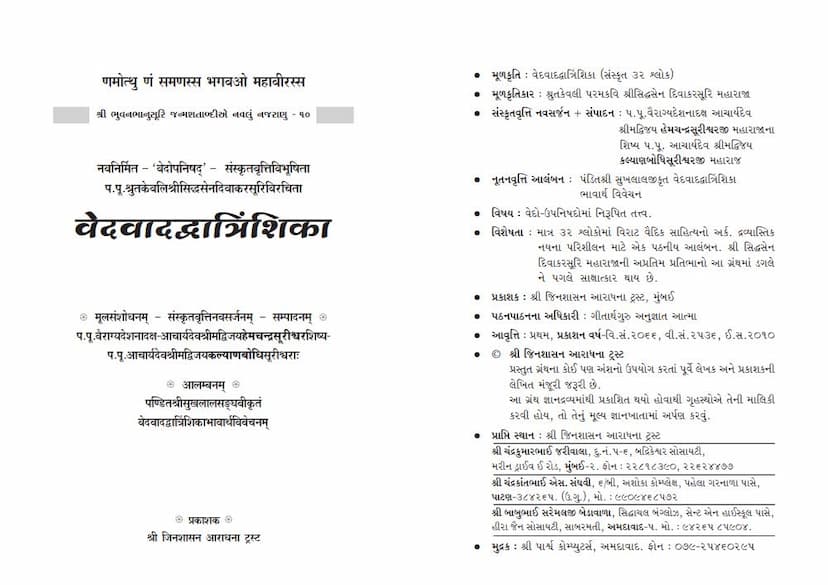Vedavada Dvantrinshika
Added to library: September 2, 2025

Summary
This is a comprehensive summary of the Jain text "Vedavada Dvantrinshika," specifically focusing on the commentary and interpretation presented in the provided pages.
Title: Vedavada Dvantrinshika (वेदवादद्वात्रिंशिका) Author of original work: Shruta Kevali Paramkavi Shri Siddhasena Divakarasuri Maharaj Commentary/Translation/Editing: Acharyadeva Shrimad Vijay Kalyanbodhisuri Ishwara (disciple of Acharyadeva Shrimad Vijay Hemchandrasuri Ishwara) Publisher: Shri Jinshasan Aradhana Trust, Mumbai Catalog Link: https://jainqq.org/explore/008879/1
Overview of the Text and Commentary:
The "Vedavada Dvantrinshika" by the esteemed Jain scholar Siddhasena Divakarasuri is a work that distills the essence of Vedic and Upanishadic philosophy into just 32 verses. This particular edition includes a Sanskrit commentary ("Vedopanishad") and editing by Acharya Vijay Kalyanbodhisuri. The commentary aims to explore the philosophical concepts presented in the Vedas and Upanishads, particularly from the perspective of the Dravyastika Naya (the perspective of substance or reality) in Jainism. It also draws inspiration and alignment from Pandit Sukhlalji's commentary on the same work.
Key Themes and Interpretations:
The commentary delves into the interpretation of the 32 verses of the "Vedavada Dvantrinshika," often comparing and contrasting them with various schools of Indian philosophy, including Sankhya, Yoga, Vedanta, and even aspects of Jain philosophy itself. The central focus is on understanding the nature of the ultimate reality, often referred to as Brahman or the Supreme Soul.
Here's a breakdown of the key themes and interpretive approaches found in the commentary:
-
The Nature of the Absolute (Brahman/Supreme Soul): The verses and their commentary explore the paradoxical nature of the Absolute. It is described as:
- Unborn (Aja): The eternal, unmanifested source.
- Sun-like (Patanga): Radiating light and consciousness.
- Multifaceted/All-pervading (Shabala, Vishwamaya): Manifesting in the entirety of the universe, yet also transcending it.
- The Immanent and Transcendent: Present within everything and yet beyond all description.
- The Controller (Adhyaksha): The governing principle behind the cosmos.
- Beyond the Vedas (Vedateetam): Transcending even the sacred scriptures, though capable of being known.
- Both the Knower and the Known: Interacting with itself in a profound way.
- The Creator and the Created: Simultaneously the source and the manifestation.
- Both Substance and Process: Enduring in its essential nature while also undergoing transformation.
- The Source of All, Yet Not Defined by Any Single Aspect: Embracing all forms and yet not limited by any.
-
The Role of Paradox and Contradiction (Virodhalankara): A significant interpretative strategy employed is the use of paradox. The commentary highlights how Vedic and Upanishadic texts frequently use seemingly contradictory descriptions to convey the ineffable nature of the Absolute. This approach is seen as essential for describing that which is beyond ordinary human comprehension.
-
Comparison with Other Philosophical Systems: The commentary actively engages with other philosophical traditions:
- Sankhya: It discusses Sankhya's dualistic perspective of Purusha (consciousness) and Prakriti (matter) and how it can be mapped onto some interpretations of the verses. However, it often moves towards an Advaitic (non-dual) understanding.
- Yoga: Similar to Sankhya, Yoga's principles are referenced in relation to the nature of the soul and its liberation.
- Vedanta: The commentary frequently aligns with Advaita Vedanta's emphasis on the non-dual nature of reality, where the individual soul (Atman) is ultimately identical with Brahman. It also touches upon Vishishtadvaita and Shuddhadvaita concepts.
- Jainism: While primarily interpreting Vedic texts, the commentary notes how some concepts can be understood through the lens of Jain philosophy, particularly the principles of anekanta (non-absolutism) and nayas (perspectives), especially Dravyastika Naya. It also draws parallels between the descriptions of the liberated soul in Jainism and the ultimate reality described in the Vedas.
-
The Symbolism of the Tree: The metaphor of the tree is explored, drawing from Vedic texts like the Rigveda, Atharvaveda, and Upanishads. This tree is often interpreted as the universe or existence, with its roots and branches representing various aspects of reality, including the individual soul and the Supreme Soul.
-
The Vedas and Liberation: The commentary emphasizes that while the Vedas are important, their ultimate purpose is to point towards the realization of the Supreme Soul. Knowing the Absolute is considered paramount; mere recitation or ritualistic adherence to Vedic injunctions without this realization is deemed insufficient or even futile.
-
The "Adhyatma" (Spiritual Essence): The commentary seeks the underlying spiritual essence of Vedic hymns and rituals, often seeing them as symbolic pointers to the realization of the Supreme Soul.
-
The Commentary's Approach: Acharya Vijay Kalyanbodhisuri's commentary is characterized by:
- Rigorous scholarship: Drawing upon ancient manuscripts and textual analysis.
- Comparative philosophy: Engaging with multiple Indian philosophical schools.
- Emphasis on reconciliation: Attempting to find harmony between different interpretations and traditions where possible, while also highlighting areas of divergence.
- Respect for tradition: While offering new interpretations, it acknowledges and builds upon the work of previous commentators, particularly Pandit Sukhlalji.
Key Takeaways:
The "Vedopanishad" commentary on "Vedavada Dvantrinshika" offers a profound exploration of the ultimate reality as described in Vedic literature, interpreted through a sophisticated philosophical framework that integrates insights from various Indian traditions, with a particular leaning towards a non-dualistic understanding of the Absolute. It highlights the importance of direct realization over ritualistic adherence and emphasizes the paradoxical yet ultimately unified nature of the Supreme. The work underscores the idea that all existence emanates from and is sustained by this singular, all-pervading, and transcendent yet immanent reality.